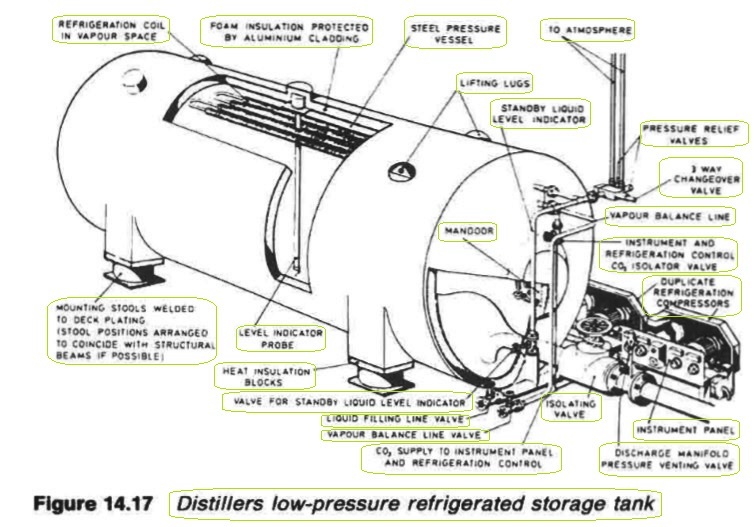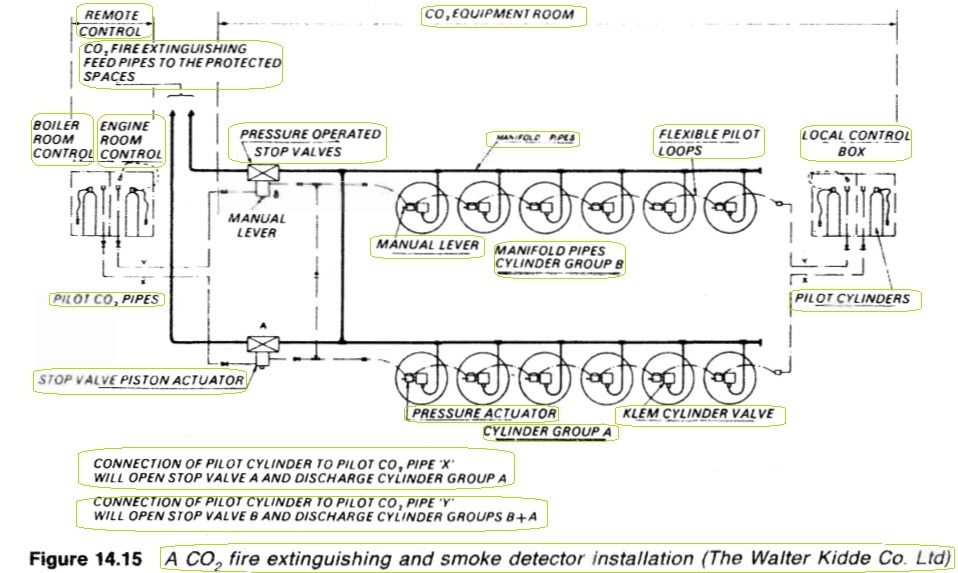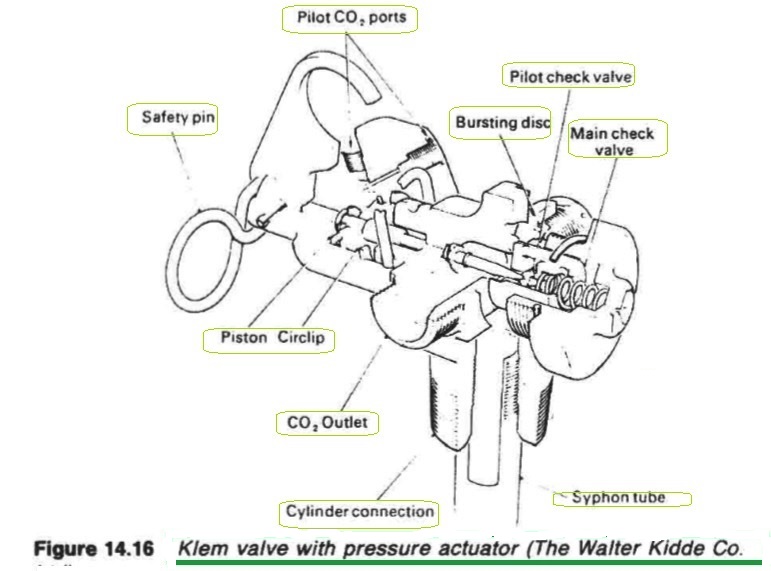
Home page||Fire protection||
Low pressure CO2 storage for Ship fire protection systems
In some installations, the CO2 is stored in low pressure refrigerated tanks. The
cylindrical storage vessels (Figure 14.17) are fabricated to the pressure vessel
requirements of the authorities. The tanks are of low temperature steel, fully
tested and stress relieved. They are mounted on supports designed to
withstand shock from collision. The insulation to limit heat ingress into the
CO2/ which is stored at a temperature of — 17 deg C, is polyurethane with fire
resistant additives, foamed in situ.

Figure : Distillers low-pressure refrigerated storage tank

Figure : A CO2 fire extinguishing and smoke detector installation (The Walter Kidde Co. Ltd)

Figure : Klem valve with pressure actuator (The Walter Kidde Co.
Ltd)
Two refrigeration compressors connected to separate evaporator coils
mounted inside the pressure vessels, maintain the CO2 at the required
temperature of — 17°C. One unit is sufficient to deal with heat ingress into the
CO2 the other unit is a stand-by. Either water or air cooling can be arranged.
The duty from main to stand-by unit can be reversed to equalize running hours,
'The instrument panel contains tank contents gauge, pressure gauge and alarms
to indicate CO2 liquid level and pressure and also contains the refrigeration
controls,
To ensure that a dangerous high pressure condition does not exist if a
serious refrigeration fault develops, pressure relief valves are fitted discharging
directly to atmosphere. The valves are mounted on a changeover valve and are
set to discharge CO2 gas if the pressure in the vessel rises above the design
pressure of 23.8 bar. Each valve can in turn be isolated for removal and periodic
testing.
The vessels are fitted with a capacitance type continuous indicator together
with a stand-by liquid level indicator which ensures that CO2 liquid level can
always be checked approximately by opening the stand-by liquid level
indicator valve which will flood the pipe to the same level as the pressure
vessel. A frost line will appear due to the low temperature of the liquid CO,.
Closing the valve will cause the CO2 to vaporize back into the pressure vessel
The filling and balance lines are normally run to the main deck port and
starboard sides for hose connections to be made to a road tanker. The balance
line is used to equalize pressure with the tanker during the filling operation.
The liquid CO2 discharge is through a 150mm bore pipe fitted with an
isolating valve but the quantity of CO2 discharged into the various spaces is
controlled by timed opening of a discharge valve. A relief valve is fitted which
will, relieve excess pressure in the discharge pipe should the isolating valve be
closed with liquid CO2 trapped in the discharge manifold. Automatic or remote
operation can be achieved by utilizing CO2 gas pressure from the top ot the
tank as the operating medium.
Because of the considerably reduced amount of steel, the storage tank
compared with cylinders gives an approximate 50% weight saving and
because low pressure CO2 has a greater density than CO2 at ambient
temperature, the volume it occupies is considerably less in terms of deck space.
Also, low pressure CO usually costs considerably less than CO supplied in
cylinders.
A periodical survey of the refrigeration compressors is required by the
Classification Societies and this is limited normally to the exchange of pressure
relief valves. At intervals of up to 10 years an internal inspection is required via
the man-door provided.
Summarized below general cargo ship fire protection equipments & guideline:
- Fire main system & related mechanism
The fire main
extends to the full length of the ship and from the machinery spaces to the
highest levels. Hydrants served by the main, are situated so that with suitable
hoses any area on the ship can be reached.
.....more
- CO2 fire extinguishing installation
Fire extinguishing installations employing CO2 stored under pressure at
ambient temperature are extensively used to protect ships' cargo compartments,
boiler rooms and machinery spaces. When released the CO2 is distributed
throughout the compartment, so diminishing the relative oxygen content and
rendering the atmosphere inert.
...... more
- Fire fighting equipments
Two independently powered pumps must be provided in all cargo ships of 1000 tons gross and over and in passenger ships of less than 4000 tons gross. Larger passenger vessels and passenger ferries must have three such pumps. The pumps are fitted with non-return valves if they are of the centrifugal type, to prevent loss of water back through open valves when not running.
..... more
- Details of fire detectors
A variety of devices are available for detecting fire in unmanned machinery
spaces but each has an ability to detect basically only one aspect. Thus, smoke
detectors based on the ionization chamber are able to recognize combustion
products but will not register radiation from a flame or heat.
.....more
- Machinery space fire & use of Walter Kidde CO2 system
Walter Kidde CO2 system employs pilot
CO2 cylinders to open the distribution system main stop valve and
subsequently the valves on the individual CO2 cylinders.
.....more
- Fire protection system for cargo holds
Holds for general cargo, have been protected against fire by fixed installations which deliver inert gas from an inert gas generator based on combustion of fuel (similar to the system available for inerting oil tankers) and halon systems.
.....more
- Low pressure CO2 storage
In some installations, the CO2 is stored in low pressure refrigerated tanks. The
cylindrical storage vessels are fabricated to the pressure vessel
requirements of the authorities. The tanks are of low temperature steel, fully
tested and stress relieved. They are mounted on supports designed to
withstand shock from collision.
..... more
- Halon system
Halon 1301 has the chemical formula CF3 Br being known as bromo-trifluoromethane.
It is a colourless, odourless gas with a density five times that of air and
extinguishes fire by breaking the combustion chain reaction.
.....more
- Multi-spray system for the machinery spaces
This system is similar to the sprinkler used in accommodation areas but the spray heads are not operated automatically. The section control valves (Figure 14.20) are opened by hand to supply water to the heads in one or more areas. Ready to use hoses can also be supplied. Fresh water is used for the initial charging and the system is brought to working pressure by means of the compressed air connection.
.....more
- Automatic sprinkler system
A network of
sprinkler heads is arranged throughout the spaces to be protected. Each sprinkler head is normally kept closed by a quartzoid bulb which is almost filled with a liquid having a high expansion ratio.
.....more
- Details various portable extinguishers & how to use ?
The first line of defence against fire in any area of the ship, is the portable fire extinguisher. Some common portable extinguishers that have been used at sea are described.
.....more
Home page||Cooling ||Machinery||Services ||Valves ||Pumps ||Auxiliary Power ||Propeller shaft ||Steering gears ||Ship stabilizers||Refrigeration||Air conditioning ||Deck machinery||Fire protection||Ship design
||Home ||
General Cargo Ship.com provide information on cargo ships various machinery systems -handling procedures, on board safety measures and some basic knowledge of cargo ships that might be useful for people working on board and those who working in the terminal. For any remarks please
Contact us
Copyright © 2010-2016 General Cargo Ship.com All rights reserved.
Terms and conditions of use
Read our privacy policy|| Home page||


